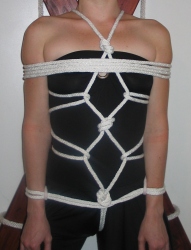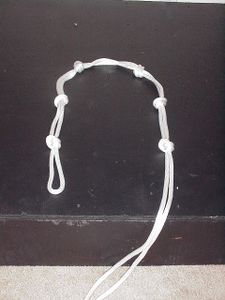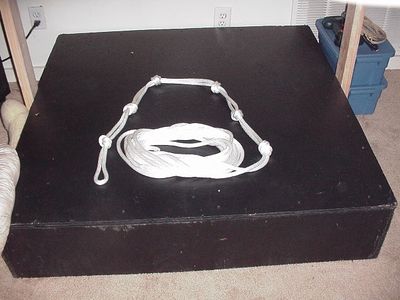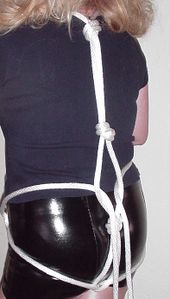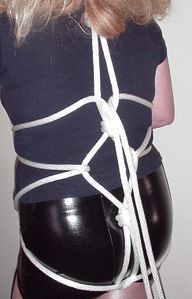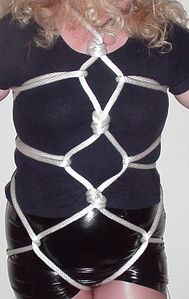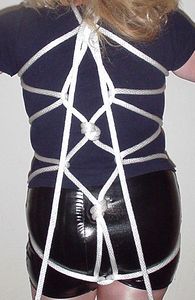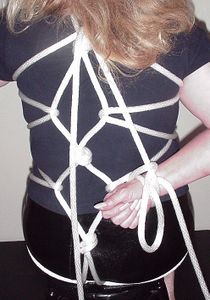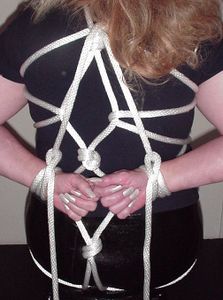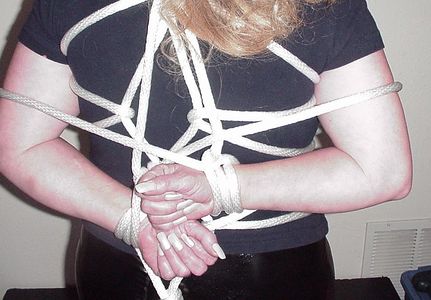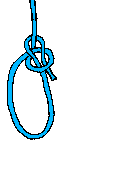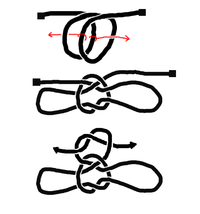Rope dress
A bondage rope harness, sometime also referred to as a rope dress, bondage web, rope web or karada, is a bondage technique involving the tying of an intricate structure of rope around the body in a complex web-like fashion.
Similar in effect to a leather bondage harness, a bondage rope harness is not in itself normally used to bind a person, but it does apply pressure over the area bound and can be used as a securing point for other bondage techniques, including suspension bondage. It is not normally used to bind the limbs but you can bind the arms into the harness by simply going around the arms not under, as shown in the picture. A rope dress is often used with, or integrated with, a crotch rope and/or a shinju ("pearl") breast harness.
A rope dress typically takes around 10-15 meters of rope to tie, and involves multiple passes of rope from front to back around the body to build up the characteristic diamond-shaped rope pattern, typically starting from a rope halter (as in the illustration) and moving down the body. In some cases, a rope harness may extend beyond the torso, into diamond-patterned webs that extend down the length of the arms or legs.
The Japanese term karada means simply "body". Traditionally, a distinction was made between kikkou ("turtle-shell" pattern; hexagonal) and hishi (diamond) patterned ties, although many modern sources just use the term kikkou to refer to any rope body harness.
- <Flame Bait> ON
It appears that most of the "neo-shibari" practitioners use bondage as a performance art instead of a part of sensual bondage.
I have often said that sensual bondage is a part of the journey, but it is not the final destination. I tie up people because I want to see someone in the room get sexually excited. <Wide-eyed evil grin>
- </Flame Bait> OFF
Also, as a professional bondage photographer, I am usually paying a professional model "multiple dollars per hour rate" to place them in bondage and take photos. (Unbelievably, most bondage models do not do it for free!)
For both of these reasons, I developed "my own style" of rope dress that uses half-hitches instead of the square knots used by the "Shibari Artists".
- Start with a piece of rope about 50 feet long.
- Fold it in half and then tie six knots about ten or so inches apart on the folded end.
- Untie either knot three or four and place the rope over the head of your victim/volunteer, and then retie the knot you just untied in the step above, so that you have three knots front in back.
- Take the free ends and pass them between the legs and pass it through the hole created between knot number one and the end fold.
- Pass the free ends around the outside of the legs and pass them though the hole created between knots five and six.
- Pass then back around the body and through the hole created between knots one and two.
- Step and repeat until holes between every knot form a diamond design.
The size of the "Bondee", the number of knots, and the distance between the knots tied in step #2 will determine the size and shape of the diamonds being made.
The concept of the Rope Dress is basically that it forms a platform for further bondage. In the example below, I then use the free ends to tie wrists together, and then arms to the body. I could have used the ends to tie wrists to ankles in a classic hogtie, or any number of other options. Like I said, this is a part of the journey: where you go, and what you do is left up to the student.
See also G-string bondage
Gallery
There are so many, many knots available to us all. There are three specific knots that I will talk about here.
This knot can tie two ropes or two ends of a rope together.
This knot is used to tie a non-slip loop on the end of a rope
I think the usage of this handcuff knot is self-explanatory
The name of the game is "Bondage and Discipline", not "Cuffs and Discipline". Bondage is an elemental part of B&D sessions. If you are insecure about your knot-tying abilities, your client will definitely notice it.
These three knots above should be considered 'bare minimum requirements' for anyone wishing to do sessions. For safety reasons, you should also be able to tie and untie them in the dark.
See also Curricula and/or Rope and Knot terms

|
This article is about either
|
What links here • References and Sources • Contact info • Category:Root ⤴
